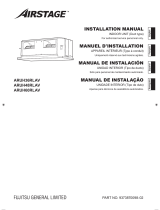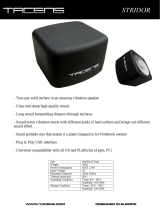
En-1
Do not modify power cable, use extension cable or branch wiring. Improper use may
cause electric shock or re by poor connection, insufcient insulation or over current.
Do not purge the air with refrigerants but use a vacuum pump to vacuum the installation.
There is no extra refrigerant in the outdoor unit for air purging.
Using the same vacuum pump for different refrigerants may damage the vacuum pump
or the unit.
Use a clean gauge manifold, vacuum pump and charging hose for R410A exclusively.
Do not modify this unit, such as opening a hole in the cabinet.
During the pump-down operation, make sure that the compressor is turned off before
you remove the refrigerant piping.
Do not remove the connection pipe while the compressor is in operation with 3-way
valve open. This may cause abnormal pressure in the refrigeration cycle that leads to
rupture and even injury.
CAUTION
Indicates a potentially hazardous situation that may result in
minor or moderate injury or damage to property.
This unit must be installed by qualied personnel with a capacity certication of handling
refrigerant uids. Refer to regulation and laws in use on installation place.
Install the unit by following local codes and regulations in force in the place of
installation, and the instructions provided by manufacturer.
This unit is part of a set constituting an air conditioner. The unit must not be installed
alone or be installed with device not authorized by the manufacturer.
When installing pipes shorter than 3 m, sound of the outdoor unit will be transferred to
the indoor unit, which will cause large operating sound or some abnormal sound.
Always use a separate power supply line protected by a circuit breaker operating on all
wires with a distance between contact of 3 mm for this unit.
To protect the persons, earth (ground) the unit correctly, and use the power cable
combined with an Earth Leakage Circuit Breaker (ELCB).
The units are not explosion proof, and therefore should not be installed in explosive
atmosphere.
This unit contains no user-serviceable part. Always consult experienced service
technician for repairing.
When moving or relocating the air conditioner, consult experienced service technicians
for disconnection and reinstallation of the unit.
Children should be monitored to ensure they do not play with the device.
This appliance is not intended for use by persons (including children) with reduced
physical, sensory or mental capabilities, or lack of experience and knowledge, unless
they have been given supervision or instruction concerning use of the appliance by a
person responsible for their safety. Children should be supervised to ensure that they
do not play with the appliance.
Do not touch the aluminium ns of heat exchanger built-in the indoor or outdoor unit to
avoid personal injury when you install or maintain the unit.
Do not place any other electrical products or household belongings under indoor unit or
outdoor unit. Dripping condensation from the unit might get them wet, and may cause
damage or malfunction of the property.
2. ABOUT THIS PRODUCT
2.1. Precautions for using R410A refrigerant
WARNING
Do not introduce any substance other than the prescribed refrigerant into the
refrigeration cycle. If air enters the refrigeration cycle, the pressure in the refrigeration
cycle will become abnormally high and cause the piping to rupture.
If there is a refrigerant leak, make sure that it does not exceed the concentration limit.
If a refrigerant leak exceeds the concentration limit, it can lead to accidents such as
oxygen starvation.
Do not touch refrigerant that has leaked from the refrigerant pipe connections or other
areas. Touching the refrigerant directly can cause frostbite.
If a refrigerant leak occurs during operation, immediately vacate the premises and
thoroughly ventilate the area. If the refrigerant comes in contact with a ame, it produces
a toxic gas.
The basic installation work procedures are the same as conventional refrigerant models.
However, pay careful attention to the following points:
Note: This manual outlines how to install the air conditioner described above. Handling
and installation shall only be done by professionals as outlined in this manual.
1. SAFETY PRECAUTIONS
• Be sure to read this manual carefully before installation.
• The warnings and precautions indicated in this manual contain important information
pertaining to your safety. Be sure to observe them.
• Hand this manual, together with the operating manual, to the customer. Request the
customer to keep them on hand for future use, such as for relocating or repairing the
unit.
WARNING
Indicates a potentially or imminently hazardous situation which, if
not avoided, could result in death or serious injury.
To avoid getting an electric shock, never touch the electrical components soon after the
power supply has been turned off. After turning off the power, always wait 10 minutes or
more before you touch the electrical components..
Installation of this product must be done by experienced service technicians or
professional installers only in accordance with this manual. Installation by
non-professional or improper installation of the product may cause serious accidents
such as injury, water leakage, electric shock, or re. If the product is installed in
disregard of the instructions in this manual, it will void the manufacturer’s warranty.
Do not turn on the power until all work has been completed. Turning on the power
before the work is completed can cause serious accidents such as an electric shock or
re.
If refrigerant leaks when you are working, ventilate the area. If the leaking refrigerant is
exposed to a direct ame, it may produce a toxic gas.
Installation must be performed in accordance with regulations, codes, or standards for
electrical wiring and equipment in each country, region, or the installing place.
Do not use this equipment with air or any other unspecied refrigerant in the refrigerant
lines. Excess pressure can cause a rupture.
During installation, make sure that the refrigerant pipe is attached rmly before you
run the compressor. Do not operate the compressor under the condition of refrigerant
piping not attached properly with 3-way valve open. This may cause abnormal pressure
in the refrigeration cycle that leads to rupture and even injury.
When installing or relocating the air conditioner, do not mix gases other than the
specied refrigerant (R410A) to enter the refrigerant cycle.
If air or other gas enters the refrigerant cycle, the pressure inside the cycle will rise to
an abnormally high value and cause rupture, injury, etc.
For the air conditioner to work appropriately, install it as written in this manual.
To connect the indoor unit and outdoor unit, use air conditioner piping and cables
available locally as standard parts. This manual describes proper connections using
such installation set.
1. SAFETY PRECAUTIONS ............................................................................................1
2. ABOUT THIS PRODUCT ............................................................................................1
2.1. Precautions for using R410A refrigerant ............................................................1
2.2. Special tools for R410A refrigerant ....................................................................2
2.3. Accessories ........................................................................................................2
3. GENERAL SPECIFICATION .......................................................................................2
3.1. Selecting circuit breaker and wiring ...................................................................2
3.2. Selecting the pipe material .................................................................................2
3.3. Pipe requirements ..............................................................................................3
3.4. Additional charging amount ................................................................................3
4. INSTALLATION WORK ............................................................................................... 3
4.1. Selecting an installation location ........................................................................3
4.2. Installation dimensions .......................................................................................3
4.3. Placing the unit ...................................................................................................4
4.4. Drain installation .................................................................................................4
4.5. Secure the unit ...................................................................................................5
5. PIPE INSTALLATION ..................................................................................................5
5.1. Brazing ...............................................................................................................5
5.2. Pipe connection ..................................................................................................5
5.3. Sealing test ........................................................................................................6
5.4. Vacuum process ................................................................................................6
5.5. Additional charging .............................................................................................7
6. ELECTRICAL WIRING ................................................................................................7
6.1. Notes for electrical wiring ...................................................................................7
6.2. Wiring method ....................................................................................................8
7. TEST RUN ...................................................................................................................9
8. CHECK LIST ................................................................................................................9
9. LED DISPLAY ..............................................................................................................9
AIR CONDITIONER
INSTALLATION MANUAL
PART No. 9381387007-02
Outdoor Unit
Contents
9381387007-02_IM_EN.indd 1 3/10/2017 09:35:20











